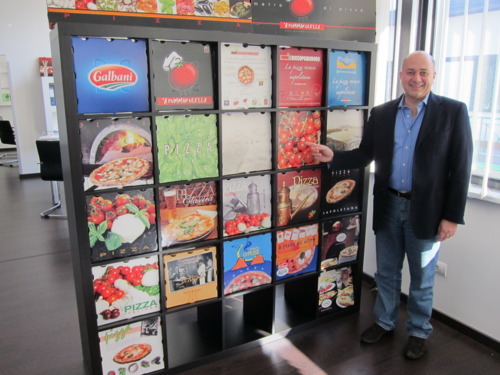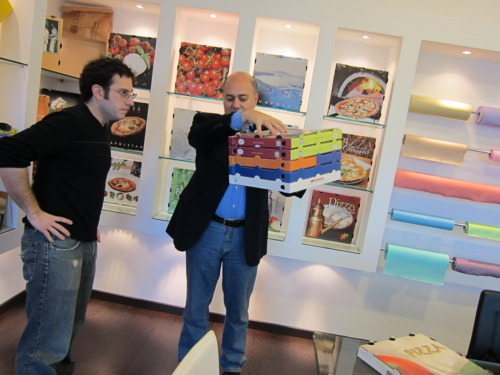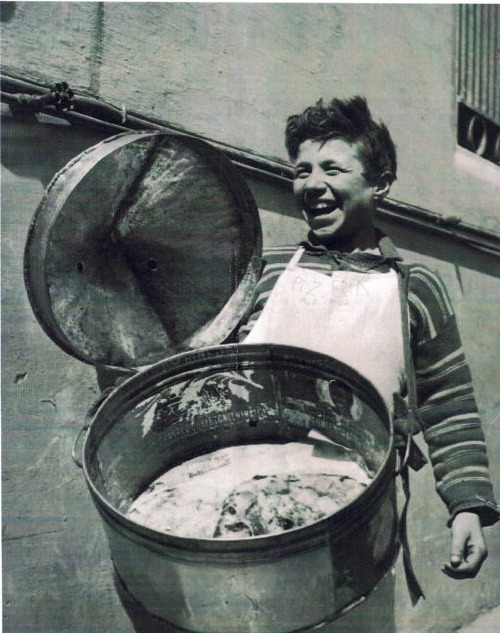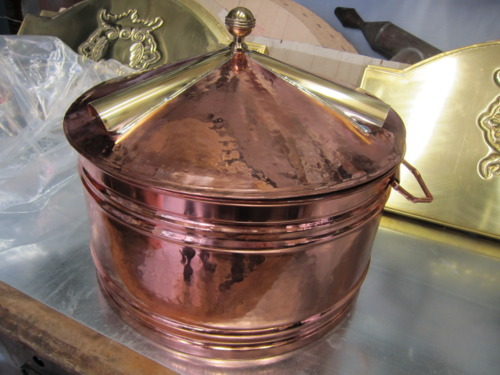This is the third post in a series about my recent trip to Italy.
Just a couple weeks before my trip to Naples, I stumbled upon an incredible pizza box that completely changed my concept of the universe. Even though I collect boxes from all around the world, I’ve never been a big user of them myself because of a mountain of negatives. My crust gets soggy, the pie tastes like cardboard, and the dang thing is a pain in the tush to dispose of. I’ve always dreamed of inventing the perfect box that would correct these major issues, but my mission was rendered unnecessary the moment I found this modern marvel at Rossopomodo in Manhattan’s Eataly Italian superstore.
After posting a video about the box’s many features, I was invited to tour the manufacturer’s headquarters in Naples. I spent a day with the owner of iPack & Trade, Diego Rubino. It was one of the most amazing days of my life.

The beautiful photo-quality artwork on the box tops are super eye-catching, but the box’s technical functions are even more captivating. Diego explained that Italy has very strict laws regarding what materials are allowed to come into contact with food. Countries that produce paper products are usually light in restrictions because of a strong paper lobby. Since Italy is not a paper producing country, paper products are severely restricted. This is why some pizza boxes in Italy feature food-safe linings and advanced construction.
The big problem is that nobody wants to invest in such a fancy pizza box when low-end options are readily available. According to Diego, 95% of the pizza boxes in Italy are illegal because they have no barrier to protect food items from direct contact with recycled paper. In fact, Diego and his colleagues at iPack & Trade are so adverse to being lumped in with common box producers that they refer to their products as containers.
“Boxes are for carting things from place to place, not for delivering carefully crafted food” is Rubino’s general sentiment. Why put so much time and effort into crafting a perfect pizza only to damn it to a life sentence of sogginess inside a cardboard coffin? It’s simple: paper goods are the easiest piece of the budget to cut and iPack & Trade’s containers are roughly three times the cost of standard low end boxes.
Before heading to Naples, I was able to figure out most of the iPack’s features. There’s ample ventilation; the interior coating helps retain heat; containers are 100% recyclable; and the printing is super high quality. Tons of features, but I missed a few and Diego was more than willing to show me.
As Diego demonstrated, the innermost section is an extremely thin sheet of polyester. The purpose of this sheet is three-fold; it retains heat, deflects grease (keeping the materials recyclable!) and prevents food from coming into contact with recycled paper. This contact is fine for some foods but not when humidity or solvents such as oil and other fats are present. Pizza fails both tests, so particles of recycled paper break down in its presence. That’s why take-out pizza tastes like cardboard. He also showed me that only a thin film of water-soluble glue is necessary to adhere the polyester to the recycled paper, so running it under warm water for a few seconds is all it takes to separate the two materials for recycling. This polyester layer is extremely durable, so the standard pizza wheel cannot puncture it.
The final feature utilizes several cardboard tabs created by the opening of ventilation ports around the perimeter of the container top. These tabs form a “U” shape inside which an additional pizza container can fit. When stacking several pizzas, this has the effect of holding multiple containers in place.


There’s some pretty impressive stuff going on here but it’s all very simple. The heat retaining / humidity dispersing features of the container reminded me of an object I’ve seen in a few Neapolitan pizzerias around New York and Naples called a stufa (literally a stove). These little tubs were used to carry stacks of pizzas around the streets of Naples to be sold as snacks for a few cents apiece. Carrying them was usually the job of a baker’s son, who would hoist the copper case either on his head or tied over his shoulder. That’s right, it’s the world’s first pizza box.

It turns out that Diego used to be a stufa boy in Naples (although that’s not him in the photo) so this pizza box of the future is actually based on the archaic pizza box of the past. My pizza box collection wouldn’t be complete without a stufa so Diego tracked down the craftsman who makes them just a few blocks away. We made a quick stop, thanks to a call from Rossopomodoro’s CEO Franco Manna, and saw a freshly finished stufa as it was being prepared for shipping. This one wasn’t going back to New York with me, but I have a feeling I’ll be placing an order for the next round.


So keep your eyes peeled for amazing pizza containers from iPack & Trade. As of this moment they are only available at Rossopomodoro, with one location in New York and another in Naples, Florida. After my experience with Diego, I can honestly say I will never look at a pizza box… errr, container… the same way again.

